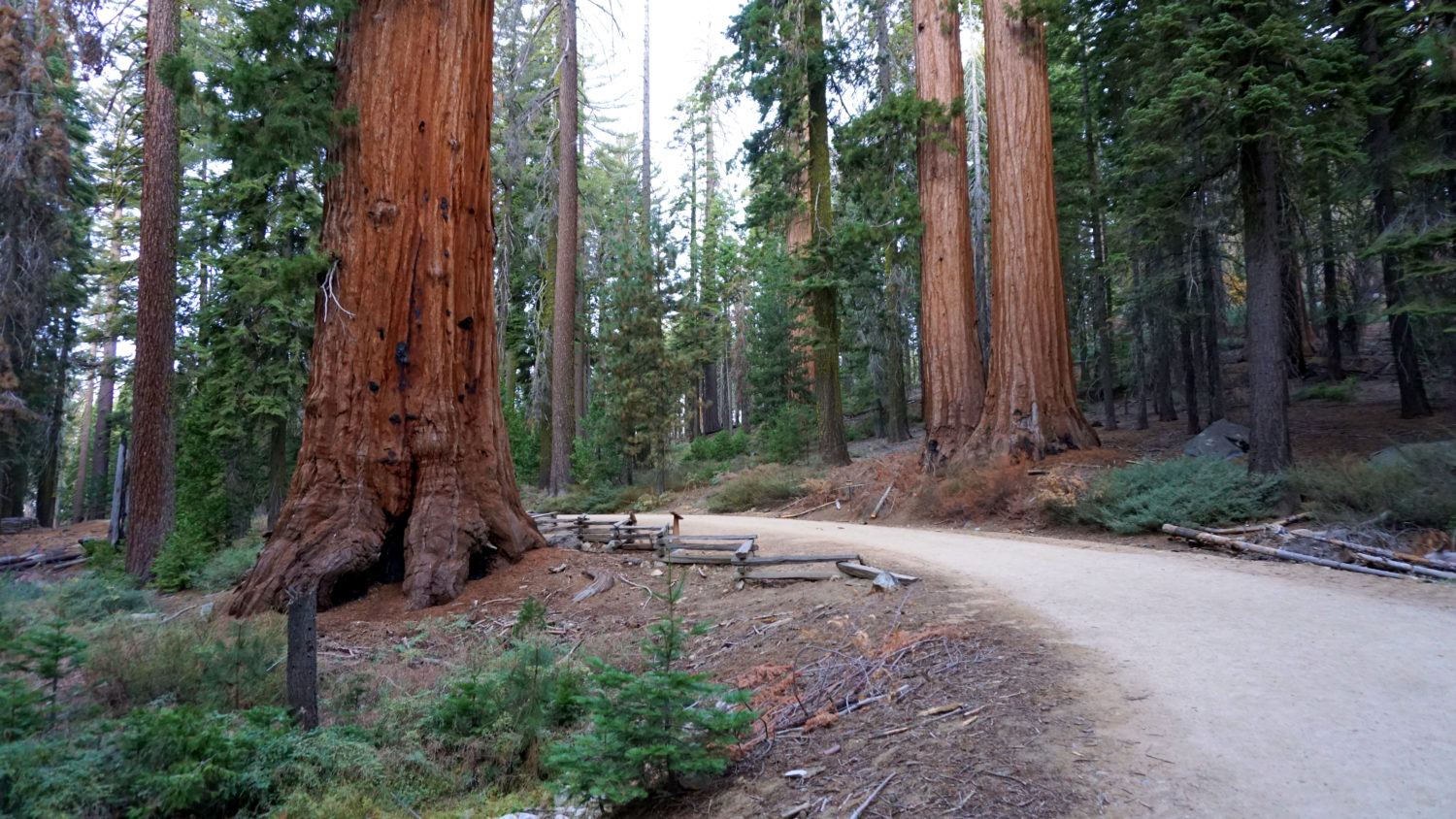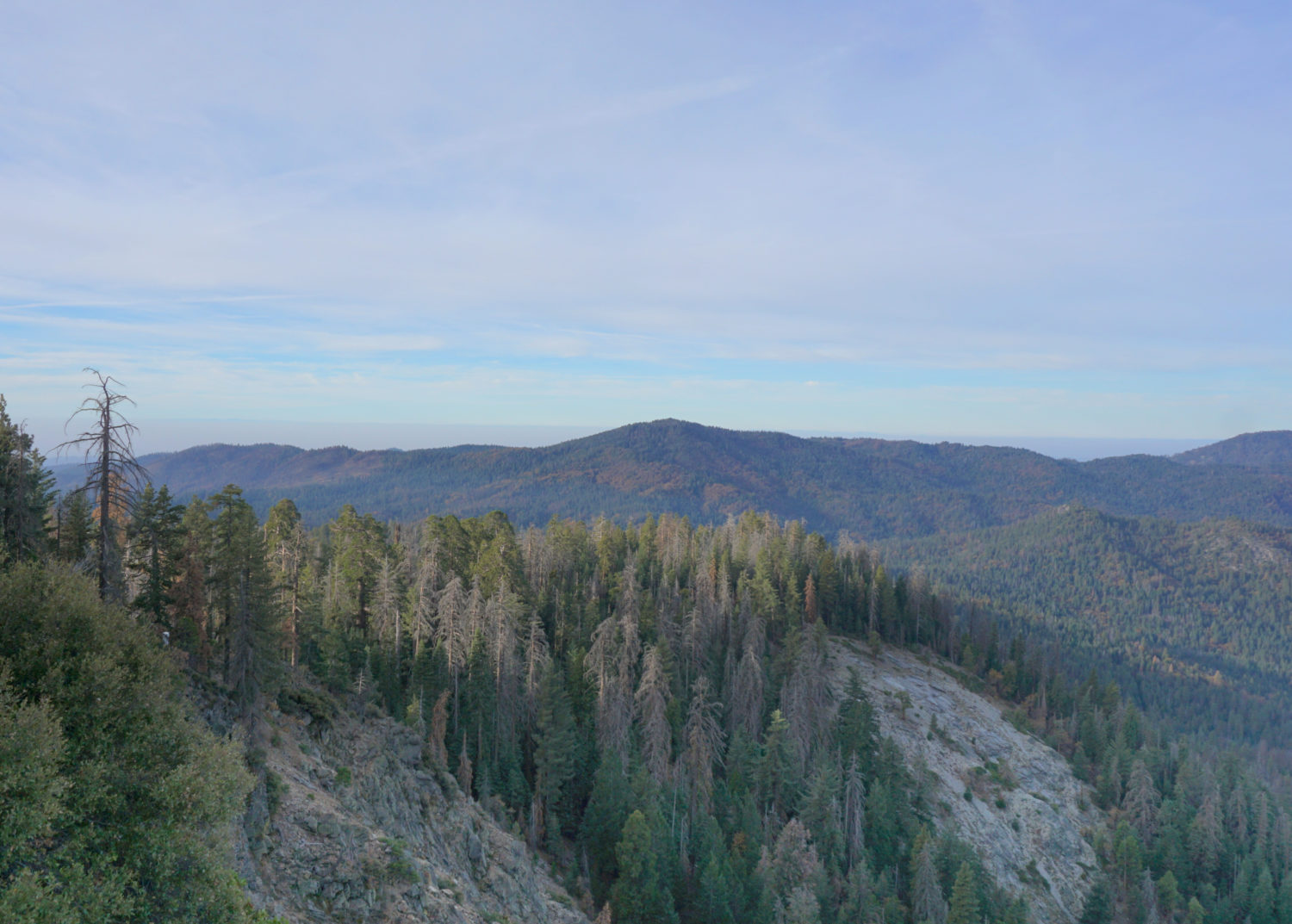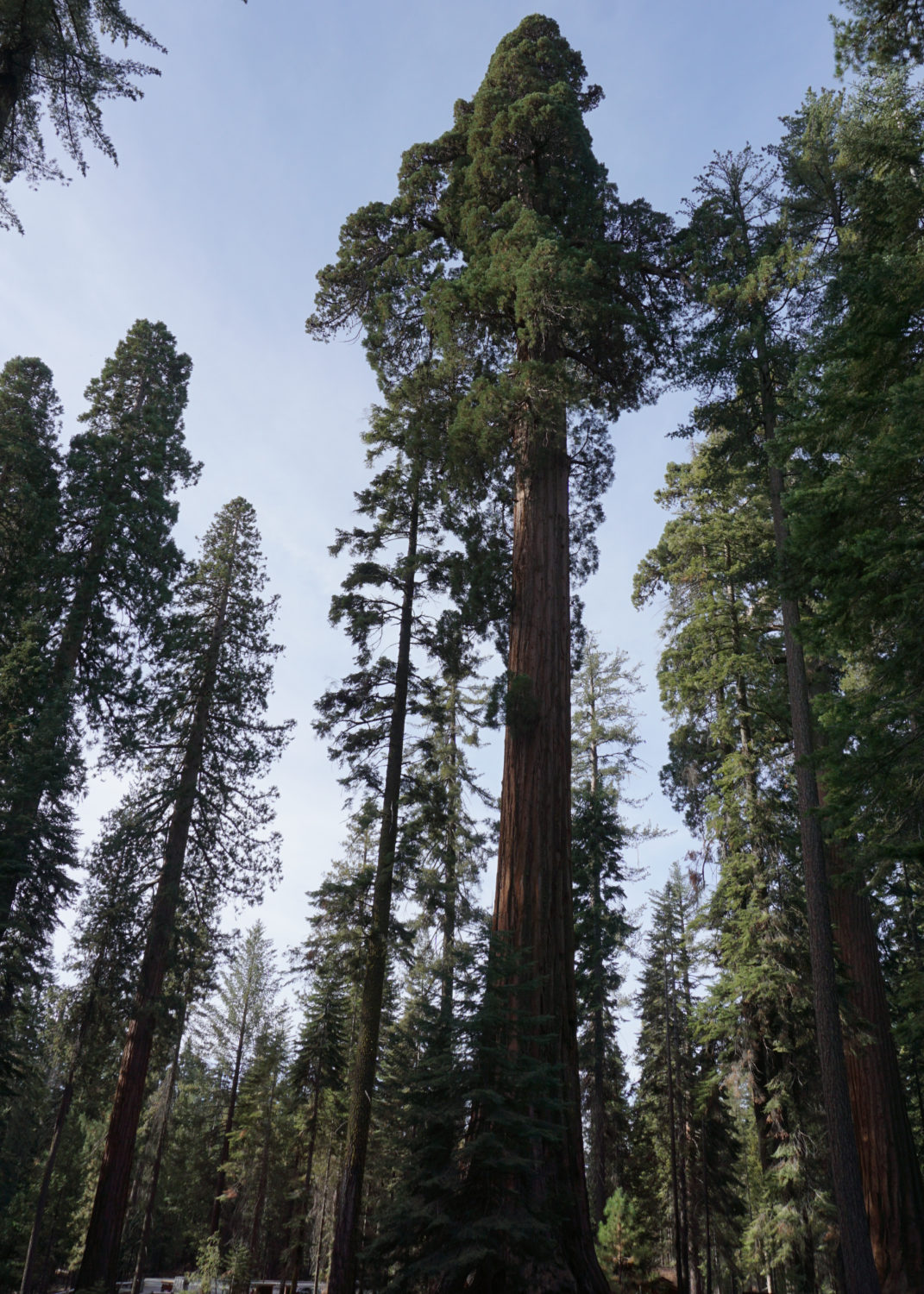The Mariposa Grove of giant sequoias reigns as Yosemite National Park’s largest sequoia grove, boasting numerous exceptional trees and an acreage that rivals the huge groves of Sequoia & Kings Canyon National Park. Rich in history and heavy on natural beauty, the grove earns its place on any top-10 “Must See” destinations for every Yosemite visitor. This comprehensive journey through the grove visits the Grizzly Giant, California Tunnel Tree, the Guardians Loop, Wawona Point, the remains of the Tunnel Tree and nearly a dozen other named trees and memorable highlights.
Red Tape

The first step in visiting the grove is to pay your entrance fee at any one of Yosemite’s five entrance gates. Since Mariposa Grove lies only a short distance from the South Entrance on CA-41/Wawona Road south of Wawona, this is the easiest entrance from which to enter the grove. At the time of writing, the park entrance fee per vehicle was $35 per automobile. If you are a regular park visitor, consider purchasing an America the Beautiful pass, which grants one year’s worth of entrance to all National Park properties for $80.
Mariposa Grove has limited parking, and the park requires visitors to use the Mariposa Shuttle Bus to reach the grove. The road to Mariposa Grove closes between November and March, and during those months the only way to reach the grove is to walk. If snow has fallen during that time frame, Mariposa Grove Road doubles nicely as a snowshoeing route, and casual hikers should be comfortable hiking the road all the way to Grizzly Giant without the hike becoming too arduous.
Safety

Wawona Valley
There aren’t a lot of things that can hurt you at Mariposa Grove, but you do need to be mindful of bears. Yosemite’s black bears have little interest in attacking or engaging with humans, but they have an enormous amount of interest in their food. If you’re carrying food with you, do not leave it unattended, as bears are prodigious thieves and can move quickly. If you have food in your car, lock it in one of the food storage lockers available at the parking area for the shuttle.
Some people may exhibit mild symptoms of altitude sickness. However, the highest elevation on the route (6813 at Wawona Point) is probably too low for the vast majority of visitors to experience altitude-related maladies.
History of Mariposa Grove

The California Tunnel Tree
For millennia, the Southern Miwok inhabited a village in the area now known as Wawona. The word Wawona derives from a Miwok word reported to mean “Big Trees,” and the area functioned as a crossroads and gathering place not too unlike the modern Wawona’s current role as a gateway to Yosemite. Like most of the Miwok peoples of the Southern and Central Sierra, the arrival of gold prospectors and ranchers drove the Miwok people from their territory, with many of them eventually settling on reservations in the San Joaquin Valley.
In recognition of the supreme beauty of Yosemite Valley and the sequoias at Mariposa Grove, President Abraham Lincoln signed into law the Yosemite Grant, which deeded these two properties to the state of California. Galen Clark, the park’s first “Guardian” – a precursor to a park superintendent – explored the grove in depth, establishing a cabin that he used to shelter visitors from occasional storms. Clark’s writings on the grove and other areas of Yosemite established him as the park’s second most famous advocate, and numerous features along this route commemorate Clark and his role in protecting the park in its early days.
Yosemite’s most famous advocate, a Scotsman named John Muir, also left an indelible imprint on the grove and on the park’s history when he entertained President Theodore Roosevelt on a camping trip at the base of the Grizzly Giant Tree (something that would surely earn you a massive ticket and a quick escort out of the park these days). During this camping trip in May 1903, Muir persuaded Roosevelt using his usual hyperbolic grandiloquence to pursue greater protection for Yosemite Valley and Mariposa Grove, which still belonged to the state of California. Muir referenced the many problems created by unchecked exploitation and visitation, along with California’s inconsistent policies on protecting the area. Three years later, Roosevelt signed off on legislation incorporating the grove and Yosemite Valley into Yosemite National Park.
Over the next century, the park’s management of the grove underwent multiple evolutions as ecologists discovered the benefits of prescriptive burns and the detriments of automobile traffic in sequoia groves, which the park allowed for decades after the grove’s inclusion into the National Park. Recently, the Yosemite Conservancy and the park completed a massive overhaul to the trail network, including the incorporation of interpretive plaques and restoration of numerous habitats within the grove.
The Giant Sequoia

sequoiadendron giganteum
Mariposa Grove’s forest composition fits under the category of “Lower Montane Forest,” a broad classification for a tree schema that occupies the elevation range between 4000 feet and 7000 feet in the western Sierra. This tree schema includes Jeffrey pines, white firs, incense cedars, sugar pines, black oaks, and dogwoods, all of which grow within Mariposa Grove. Included within the schema is the grove’s principle plant specimen, the giant sequoia.
Sequoias live for up to 3000 years, attaining heights over 300 feet, and weights equalling twenty blue whales. They are the largest single stem true measured by volume, and their indescribable and incomprehensible size and shape make them immediately recognizable. Mariposa Grove is home to about 500 mature sequoias, and it features several large trees, including the Grizzly Giant, Galen Clark Tree, and others.
Hiking Mariposa Grove
The hike begins at a boardwalk dubbed “the Big Trees Loop.” This boardwalk ascends on a gentle grade due northeast. At 0.1 mile, the trail reaches the base of a huge fallen sequoia. Interpretive plaques detail surrounding qualities in the habitat, and a paved space near the base becomes a popular spot for photographers looking to get a shot next to the massive root system.

Big Trees Loop along the Fallen Monarch
Continue beyond the Fallen Monarch on the wide Mariposa Grove Trail signed for the Grizzly Giant Tree. Ascend through lower montane forest with sporadic sequoias scattered about, and cross a creek at 0.2 mile. At 0.4 mile, the trail crosses a paved, ADA-accessible road leading to a parking area south of the Grizzly Giant. After the crossing, look for a quartet of sequoias dubbed “The Bachelor and the Three Graces.” Here, three sequoias grow close together, while one larger specimen grows apart as if he’s Hamilton determining which of the Schuyler sisters he’s going to pursue.

At 0.6 mile, keep left where a short trail leading from the ADA-accessible parking to the south joins the main trail. Directly ahead, locate the squat, gnarled, and distinctive form of the Grizzly Giant. Although Ol’ Griz is only the second largest tree in the grove – the Washington Tree takes that honor – and the 26th largest worldwide, this tree is easily the most recognizable and popular. Follow the trail around the base of the tree, and locate the plaque commemorating the spot where Muir and Teddy Roosevelt roasted marshmallows and engaged in passive-aggressive competition over who had the lightest ultralight rig.

The Grizzly Giant
Beyond the Grizzly Giant, the Mariposa Grove Trail begins a long climb to the heart of the grove, which contains a denser concentration of trees, a handful of small meadows, and access to Wawona Point’s scenic overlook. The climb progresses on a moderate grade on a wide dirt road that sees only occasional vehicle traffic from workers maintaining communications facilities at Wawona Point. Continue straight through a junction with a connecting trail reaching the Perimeter Trail just to the east. There aren’t a lot of sequoias on the segment between Grizzly Giant and the Clothespin Tree, save the Faithful Couple, which lies just beyond another trail junction at 1.5 miles. Two giant sequoias grew up close enough together that their bases fused. The trees now share water and nutrients, but when one topples, the other will go down with it.

The Faithful Couple
The trail switches back to the east beyond the Faithful Couple to approach the Clothespin Tree at 1.7 miles. Unlike the Faithful Couple’s fused base, the Clothespin Tree’s base is split down the middle, almost as if the tree is standing on stilts. Note the junction here with a trail leading to the Guardians Loop; this will be your return route from the Mariposa Grove Cabin toward the end of the hike.

The Clothespin Tree
Beyond the Clothespin Tree, the Mariposa Grove Trail wraps around a hill, leading to a junction with another connecting trail to the Perimeter Trail at 2.1 miles. A vault toilet lies along this connecting trail, and look for the signed Mariposa Tree along the road. The trail forges ahead beyond the junction in parallel with a stream-fed meadow on the right. Deer and bears browse for food here during the mornings and afternoons, and the denser concentration of sequoias combined with the meadow give this part of the grove that classic sequoia grove feel of massive trees, lush meadows, trickling streams, and brilliant shafts of sunlight bathing gardens of lupines and shooting stars.

Chowchilla Mountain from Wawona Point
At 2.5 miles, continue straight past a junction signed for the Guardians Loop and the Mariposa Grove Cabin; ignore the junction, as you’ll stop at the cabin later on. Instead, continue straight ahead to a junction with the Perimiter Trail and a road leading west to Wawona Point at 2.9 miles. Turn left here and continue to a loop in the road, which accesses some communications structures. On the west end of this loop, there’s a short spur leading downhill to the Wawona Point overlook at 3.5 miles. From this overlook, you can scan the entirety of Wawona Valley, which includes landmarks like Wawona Dome, Wawona Meadow, Chowchilla Mountain, and the thin thread of the South Fork Merced River winding through dense forest a few thousand feet below.

The Mariposa Grove Cabin
From the viewpoint, return to the junction with the Perimeter Trail and the Mariposa Grove Trail. Just before the bigger three-way junction, look for the Perimeter Trail leading north into dense forest. Follow this trail about 100 feet to a massive, unmarked sequoia. This huge sequoia is the Galen Clark Tree, named for the original Guardian of the Yosemite Grant who resided within Mariposa Grove and left an important mark on the park’s early history. Clark often hosted visitors to the grove, opening up his cabin during inclement weather and showing people the various marvels contained within. This route will visit his cabin shortly, but for now, return to the main trail, and continue south to the junction with the Mariposa Grove Trail, the Perimeter Trail, and the Guardians Loop Trail. Continue straight to join the Guardians Loop Trail.

Fallen Tunnel Tree
Shortly after joining the Guardians Loop Trail, you reach the remains of the Tunnel Tree at 4.3 miles. Early park marketing efforts sold the novelty of beveling out a tunnel through the base of sequoia as a powerful attractant for visitors. This proved true, as the novelty of driving a stagecoach through a tree was too much for people to resist. Unfortunately, this action weakened the tree, which collapsed during an epic snowstorm in 1969. Continue past the Tunnel Tree as the Guardians Loop Trail makes a gentle arc around a densely wooded bowl that contains the heart of the grove.

You will find several fine specimens on your way to a junction with the Perimeter Trail and a trail leading to the Mariposa Grove Cabin at 4.9 miles, including the Telescope Tree just to the left of the junction. Take a right here for a quick visit to Galen Clark’s former residence/headquarters/hostel cabin. Clark built the cabin in 1864 around the time he began to explore the park and advocate for its protection. He sheltered visitors here frequently, and although the cabin was a private residence-turn-ranger headquarters, it became known as “Galen’s Hospice.”

The base of the Fallen Monarch
After visiting the cabin, return to the Perimeter Trail/Guardians Loop Trail Junction. Keep right to head downhill on a switchbacking trail that creates a shortcut to the Clothespin Tree. Once at the Clothespin Tree, turn left on the Mariposa Grove Trail. From here, you will retrace your steps back to the parking area, but with two exceptions. At 6.4 miles, keep right onto a trail signed for the California Tunnel Tree. This trail leads downhill to a second tree with a tunnel carved into the base, with this one remaining standing. Satisfy your thirst for novelty by walking through it, then continue south to the Grizzly Giant Tree. Follow the Mariposa Grove Trail back to the boardwalk Big Tree Loop, but instead of going left on your starting segment, keep right to follow the boardwalk on a short loop. There’s a nice view across the fallen tree toward a few large sequoias and a handful of dogwoods, the latter of which blooms in May and June before turning crimson in November.
Tags: Big Trees Loop, California Tunnel Tree, Galen Clark, Galen Clark Tree, Giant Sequoias, Grizzly Giant, Guardians Loop, john muir, Mariposa grove, Mariposa Grove Cabin, Mariposa Grove Trail, Theodore Roosevelt, Tunnel Tree, Wawona Point, Yosemite Grant















